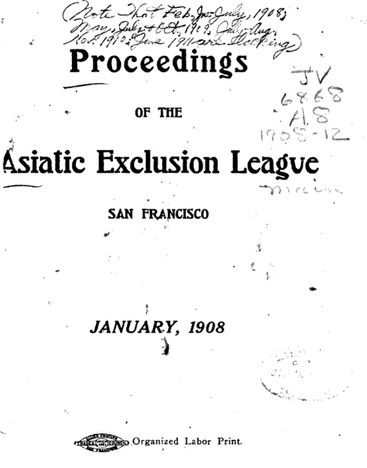The Japanese and Korean Exclusion League
Introduction
Text-to-speech Audio
The Japantown Peace Plaza, located within San Francisco's Japantown, serves as a memorial to Japanese Immigrants in the United States. San Francisco's Japantown, established in the 1860s, preserves Japanese and Japanese American culture and heritage. The Peace Plaza reminds visitors of the difficult history Japanese Americans have faced in the United States, while emphasizing their strength, perseverance, and contributions to American society.
“...that rigid exclusion is the only solution of the Oriental immigration problem” (Minutes from the Asiatic Exclusion League, December 1907).
As the Russo-Japanese War instilled discomfort among Americans between 1904 and 1905, the largest anti-Japanese group introduced itself to society. The Japanese and Korean Exclusion League, later coined the Asiatic Exclusion League, began official operations in May of 1905. Preceding the official end of the Russo-Japanese War by about four months, the League supported the rigid exclusion of Japanese immigrants to the United States. According to historian Izumi Hirobe, the creation of the Japanese and Korean Exclusion League served as the “most symbolic” representation of the growing anti-Japanese movement in the United States (Hirobe 4).
The Asiatic Exclusion League represented widely held racist beliefs not only against the Japanese, but also against all immigrants or Americans with Asian heritage. While the League, and subsequently the exclusion movement, did not make national gains in the early 20th century, their continued pressure provided a foundation for later actions against Japanese immigrants and Japanese Americans.
Images
Cover of the Proceedings of the Asiatic Exclusion League, 1908

Backstory and Context
Text-to-speech Audio
While past iterations of anti-Japanese racism adopted similar arguments as the Chinese exclusion movement, the rise of the Japanese exclusion movement of the early 1900s experienced arguments unique to Japanese immigration. Japan’s growing military power caused unease among Americans, allowing the Japanese and Korean Exclusion League to latch onto such fears to advocate against Japanese immigration (Hirobe 3). While exclusionists used Japan’s military success as an argument against Japanese immigration, many leaders in the United States, including President Theodore Roosevelt, did not support strict Japanese exclusion as they did not want to damage relations between the United States and Japan (Daniels 121). The exclusion movement thus had to adopt other arguments, such as the perceived protection of American laborers, to further expand their movement.
The League wanted to achieve complete exclusion of Japanese immigrants, first and foremost, followed by more extreme exclusion of additional Asian immigrants, in order to prevent white labor workers from competing with Asian laborers for jobs (Asiatic Exclusion League Minutes, December 1907). Thus, several years into its existence, the organization adopted the Asiatic Exclusion League as its new name, using the term “asiatic” to encompass all Asian immigrants (Kurashige 93-95).
Prominent figures in the Asiatic Exclusion League’s ranks included its president, Olaf Tveitmoe; the head of the Building Trades Council, Patrick Henry McCarthy; and James D. Phelan, who served as mayor of San Francisco from 1897-1902 and as a U.S. senator from 1915 to 1921 (Geiger 160). Both Tveitmoe and McCarthy were European immigrants, like many other members in the Asiatic Exclusion League. The roots of European immigration present in the League contributed to principles of “assimilable” immigrants, or those who could eventually adapt to American society, and “unassimilable” immigrants, or those unable to adapt. The League believed that Japanese immigrants, as well as other Asian immigrants, would never be able to assimilate to American society, no matter how many generations had lived within the United States (Asiatic Exclusion League Minutes, December 1907). This was a widely held belief by many white Americans, although it did not always lead to support for Japanese exclusion.
Even without immediate legislative success, the exclusionists did receive certain consolations. One such consolation was the Gentlemen’s Agreement of 1907, which consisted of six notes between Roosevelt and Japanese officials that led to immigration restrictions imposed by the Japanese government (Daniels 125). The Agreement led to a limitation of Japanese immigrant laborers in the U.S. (Daniels 125). While this appeased some exclusionists, the more vocal members continued to advocate for rigid exclusion.
While the Asiatic Exclusion League continued operation throughout World War I, the nation’s focus was on more pressing matters. Although the war led to a decline in Japanese exclusion efforts, such sentiments did not disappear. Anti-Japanese exclusion increased at the end of the war, leading to stricter immigration legislation and other victories for the Japanese exclusion movement throughout the 1920’s.
Sources
Chin, Doug. “The Chinese Exclusion Acts: A Racist Chapter in U.S. Civil Rights History.” Chinese American Forum 33, no. 1 (July 2017): 19-21.
Daniels, Roger. Asian America: Chinese and Japanese in the United States Since 1850. [N.p.]: University of Washington Press, 2011.
Geiger, Andrea. Subverting Exclusion: Transpacific Encounters with Race, Caste, and Borders, 1885-1928. The Lamar Series in Western History. New Haven: Yale University Press, 2011.
Hirobe, Izumi. Japanese Pride, American Prejudice: Modifying the Exclusion Clause of the 1924 Immigration Act. Asian America. Stanford University Press, 2001.
Kurashige, Lon. Two Faces of Exclusion: The Untold History of Anti-Asian Racism in the United States. Chapel Hill: The University of North Carolina Press, 2016.
Minutes from the Asiatic Exclusion League Meeting. 8 Dec. 1907. Page 3. Located in Proceedings of the Asiatic Exclusion League, 1907-1913. Anti-Movements in America. Arno Press, 1977.
"Proceedings of the Asiatic Exclusion League, 1908," digitized by Google, https://books.google.com/books?id=WrVFAQAAMAAJ&printsec=frontcover&source=gbs_ge_summary_r&cad=0#v=onepage&q&f=false.
